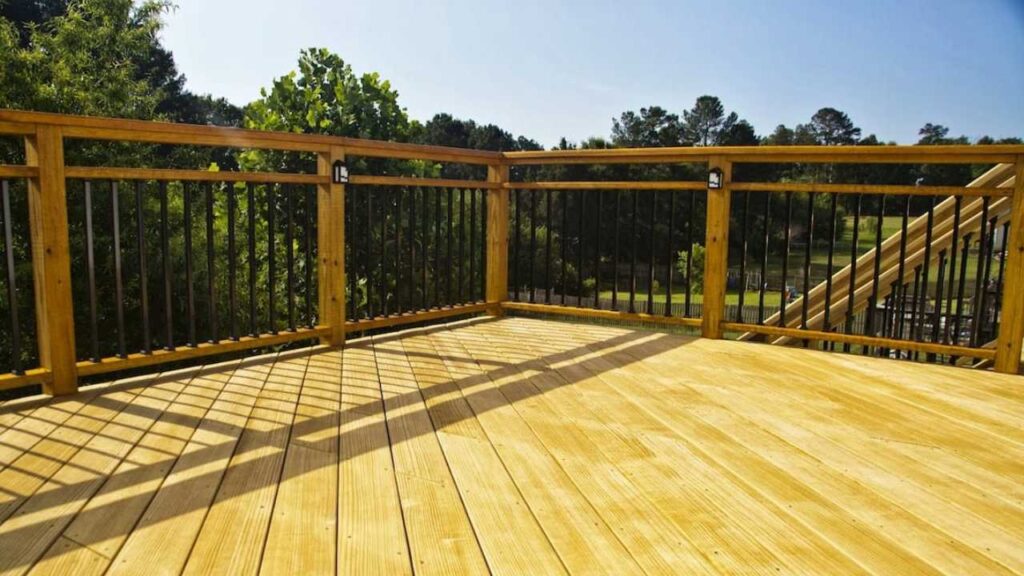Unlock the secrets to a stunning deck with the American Wood Council Deck Guide ultimate guide. From design to maintenance, find everything you need to know.
The Comprehensive Guide to Crafting Your Perfect Deck with AWC Standards
Decks are a quintessential part of the American home, providing a space for relaxation, entertainment, and a connection to the great outdoors. It’s also a significant investment, both in terms of time and financial cost. This guide, in collaboration with the American Wood Council (AWC), will walk you through the essential steps, from planning to post-build maintenance, ensuring that you produce a high-quality, durable deck that complies with safety and design standards.
Planning and Designing Your American Wood Council Deck Guide
The first step to crafting your perfect deck is thorough planning and designing. This involves considering the purpose of your deck, its location, materials, dimensions, and any necessary permits or approvals.
Purpose and Location
The primary use of your deck will determine its size, shape, and features. Will it be an outdoor dining space? A place for lounging and entertaining? Will it have a hot tub or grill? These considerations will guide your design choices.
Additionally, the location of your deck is crucial. It should be easily accessible from your home’s interior and situated in an area that provides privacy and takes advantage of natural features such as views, shade, and landscaping.
Materials
The most common material used for deck construction is wood, specifically pressure-treated lumber. It is affordable, readily available, and easy to work with. However, there are other options, such as redwood, cedar, tropical hardwoods, and composite materials made from a mixture of wood fibers and plastic.
When choosing your material, consider factors such as durability, maintenance requirements, cost, and aesthetics. Whichever material you choose should meet AWC standards for load capacity and structural integrity.
Dimensions
The size and shape of your deck will depend on various factors such as budget, available space, and desired features. However, keep in mind that larger and more complex decks may require additional support structures, resulting in increased costs.
To determine the appropriate dimensions for your deck, consult AWC’s Residential Deck Design Guide or seek the advice of a professional deck builder.
Permits and Approvals
Before beginning any construction, it’s essential to obtain the necessary permits and approvals from your local building department. This helps ensure that your deck complies with safety codes and regulations. Failure to do so can result in costly fines, delays, or even having to remove the deck entirely.
Consult with your local building department or a professional deck builder to determine the specific requirements for your area.

The Crucial Significance of Outdoor Decking
Before you even pick up a piece of lumber, it is essential to understand the role that decking plays in the overall quality and safety of your home. A well-constructed and maintained deck not only adds value to your property but also extends your living space into the fresh air. Conversely, a poorly built or neglected deck poses a significant liability and can lead to injury or property damage. This section will emphasize the importance of a solid foundation, a thoughtful design, and meticulous construction in every deck-build project.
A Preeminent Wood Selection Guide
The right wood is the soul of a sturdy deck. When you select your lumber, it’s not just about picking out the prettiest grains or the cheapest options. The type of wood you choose can mean the difference between a deck that lasts for decades and one that needs frequent repair. The AWC provides a comprehensive guide to different wood types, including pressure-treated, cedar, redwood, and tropical hardwoods, highlighting their distinct properties and recommended applications. Understanding these differences will lead to an informed choice of materials, setting the groundwork for a successful deck-build.
Tools and Equipment You Can’t Skimp On
Building a deck requires a plethora of tools, from the essential measuring tapes and circular saws to the more specialized orbital sanders and pneumatic nail guns. Skimping on quality or variety here could result in frustrating delays or dangerous situations during the construction. Fortunately, the AWC has documented a list of necessary tools for each phase of the project, affirming that having the right tools and knowing how to use them is key to efficiency and precision.
Step-by-Step Deck Construction: A Masterclass
When it comes to the actual building of your deck, precision is non-negotiable. Each step, from mark-out to finish, is crucial in ensuring a safe and long-lasting structure. The AWC’s guide on deck construction features a granular look, breaking down every layer, every joint, and every fastener, and it’s hailed by industry experts as second to none. You’ll learn about ledger board attachment, initial deck footing placement, and the intricate process of securing the deck boards themselves. By following these steps diligently, you’ll be setting your deck up for decades of happy use.
Foundation
The foundation is arguably the most critical aspect of deck construction. It provides the necessary support and stability for your deck, ensuring its safety and longevity. The most common types of foundations are concrete footings or precast piers.
It’s crucial to follow AWC standards for foundation design, including adequate depth, size, reinforcement, and spacing.
Framing
Deck framing refers to the structure that supports the deck boards and any additional features, such as railings and stairs. It’s essential to use high-quality materials that meet AWC standards for load capacity, spacing, and connections.
Proper framing techniques, such as using joist hangers and securing beams with bolts rather than nails, are crucial for ensuring the structural integrity of your deck.
Decking
The decking is the visible surface of your deck and plays a significant role in its overall appearance and functionality. It’s crucial to choose a material that is both durable and aesthetically pleasing.
Follow AWC standards for spacing, fastening, and ventilation when installing your decking to ensure proper drainage, prevent moisture buildup, and promote durability.
Maintaining that Pristine Deck for Years to Come
Even the sturdiest of structures require care, and your deck is no exception. Periodic maintenance is a necessity for preserving the integrity and aesthetic appeal of your investment. The AWC’s recommendations for maintaining your deck are detailed and easy to follow, including tips on refinishing, regular inspection, and the seasonal tasks that will keep your deck safe and beautiful.
Post-Build Maintenance
Proper maintenance is key to preserving the longevity and safety of your deck. It involves regular inspections, cleaning, and repairs when needed.
Inspections
It’s essential to inspect your deck at least once a year for any signs of damage or wear. Pay particular attention to areas prone to moisture and structural components such as posts, beams, and joists.
If you notice any issues, address them promptly before they worsen. Hiring a professional inspector is also recommended, especially for older decks or those exposed to harsh weather conditions.
Cleaning
Regular cleaning helps prevent the buildup of dirt, debris, and mold on your deck. Use a gentle cleaner specifically designed for outdoor surfaces, and avoid using harsh chemicals that can damage the wood.
Sweeping or hosing down your deck regularly can also help remove small debris before it accumulates and causes damage.
Repairs
Over time, your deck may require repairs, such as replacing damaged boards, reinforcing structural components, or fixing loose railings. These should be addressed promptly to maintain the safety and structural integrity of your deck.
Consult AWC’s Residential Deck Design Guide for specific guidelines on repairing different types of decks.
Common Pitfalls and How to Dodge Them
Learning from your mistakes is a valuable experience, but when building a deck, the stakes are too high to gamble with chances. The AWC-Specific Common Mistakes section sheds light on the errors that novice builders often make, explaining how to avoid them with foresight and careful planning. Issues like inadequate support, improper material storage, and non-compliance with building codes are all covered, providing a concise map of what not to do.
Navigating the Legalese of Deck Building
Red tape and legal requirements can be cumbersome, but compliance is critical. The AWC lays out the importance of understanding local building codes and obtaining necessary permits, ensuring that you build with the law on your side. Not only does this guarantee a safe build, but it also protects you from potential fines and sanctions.
Safety Precautions for Every DIY Enthusiast
Safety must be a non-negotiable aspect of your deck-building venture. The AWC insists on the observance of stringent safety measures from start to finish. Such precautions include but are not limited to, personal protective equipment, proper tool use, and adherence to a buddy system for high-risk activities. A safe build is a successful build, and AWC’s commitment to safety ensures that your deck is built to the highest possible standard.
Inspirational Case Studies and Testimonials
Nothing quite peels back the potential of your DIY deck project like real-life examples. The AWC features a series of case studies and testimonials from DIYers just like yourself who have benefitted from the council’s advice. From rookie mistakes to proud successes, these stories highlight the tangible impact that following the AWC guide can have on your deck’s outcome.
By following the guidance and recommendations set forth by the American Wood Council Deck guide, you are not just building a deck; you are crafting a legacy. Your newfound knowledge will empower you to take on this project with confidence and competence, ultimately leading to the realization of your personal deck oasis—a place where memories are made, and tranquility is found. Now, gather your tools, select your lumber, and get ready to build the deck of your dreams, all with the backing of AWC’s gold standard in deck-building wisdom.
Frequently Asked Questions
What is the best time of year to build a deck?
The best time to build a deck depends on your local climate. Generally, spring to early summer is ideal as the weather is mild, but it’s important to avoid rainy seasons, which can delay work and affect materials.
Can I build a deck on uneven ground?
Yes, decks can be constructed on uneven ground, but additional groundwork like leveling or the installation of support posts at varying heights may be required to ensure a stable and level deck.
How long does it take to build a deck?
The time it takes to build a deck varies based on its size, complexity, and whether you’re DIYing or hiring professionals. A simple deck might take a weekend, while a more complex build could take several weeks.
Do I need a permit to build a deck?
In most cases, yes. The requirements vary by location, so it’s important to check with your local building department to understand the permits and inspections needed for your deck.
How often should I perform maintenance on my deck?
Perform a thorough inspection and maintenance at least once a year. This includes checking for damage, cleaning, and applying a protective seal if necessary. More frequent checks may be needed based on your climate and deck materials.
Conclusion on American Wood Council Deck guide
Building a deck is an endeavor that requires careful planning, adherence to safety protocols, and a keen eye for detail. By leveraging the insights and guidelines provided by the American Wood Council Deck guide, you’re equipped with the knowledge to avoid common pitfalls and ensure your deck is not only beautiful but built to last. Remember, the success of your project hinges on your preparation and the decisions you make along the way.
Whether it’s through selecting the right materials, obtaining the necessary permits, or conducting regular maintenance, each step is a building block toward creating a space that enhances your outdoor living experience. May your deck become a cherished space for relaxation, gatherings, and making memories for years to come.




